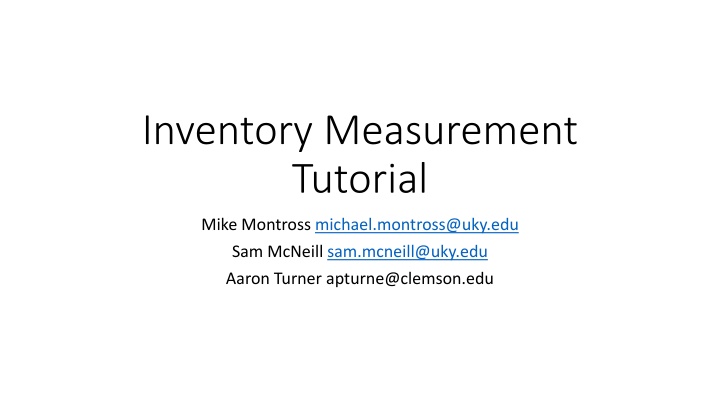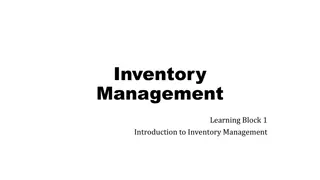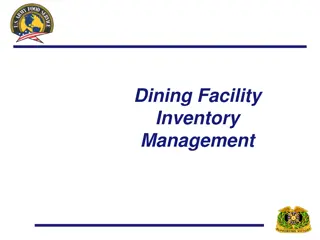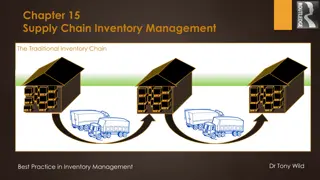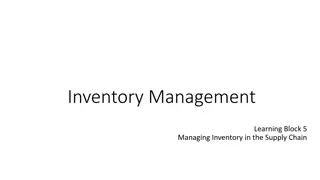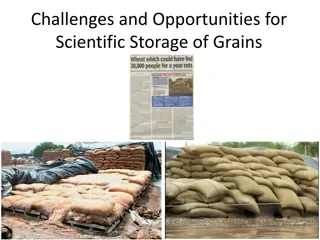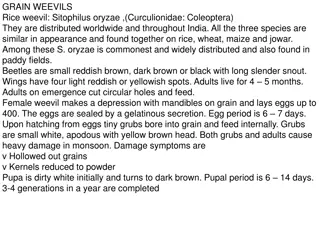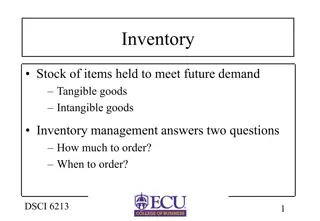Excel Inventory Management Tutorial for Agricultural Grain Storage
Excel Inventory Model for tracking incoming and outgoing grain based on scale weights, estimating quantity stored in bins, and managing inventory uncertainties. Includes detailed instructions for setting up the model, entering bin measurements, and utilizing pivot tables for data analysis.
Download Presentation

Please find below an Image/Link to download the presentation.
The content on the website is provided AS IS for your information and personal use only. It may not be sold, licensed, or shared on other websites without obtaining consent from the author.If you encounter any issues during the download, it is possible that the publisher has removed the file from their server.
You are allowed to download the files provided on this website for personal or commercial use, subject to the condition that they are used lawfully. All files are the property of their respective owners.
The content on the website is provided AS IS for your information and personal use only. It may not be sold, licensed, or shared on other websites without obtaining consent from the author.
E N D
Presentation Transcript
Inventory Measurement Tutorial Mike Montross michael.montross@uky.edu Sam McNeill sam.mcneill@uky.edu Aaron Turner apturne@clemson.edu
Purpose of Excel Inventory Model Track incoming and outgoing grain based on scale weights Estimate quantity of grain stored in bins including packing Official scale weights are the standard, estimating inventory in the bin has a high level of uncertainty. Entering into contracts based on bin measurements or on-farm weights is not advised.
Excel Inventory Model Four tabs Summary BinData Inventory ScaleLog Ignore Summary tab for now. Uses pivot tables to summarize results. Two hidden sheets with formulas, conversions, and other data
Model Farm Four bins Bin 1 is 30 ft diameter and height of 30 ft to the bottom of the manhole Bin 2 is 24 ft diameter and height of 24 ft to the bottom of the manhole. Bin 3 is 48 ft diameter and height of 48 ft to the bottom of the manhole Overhead is a hopper bottom overhead tank. Diameter is 12 ft and height of the cylinder is 9 ft. The hopper has an angle of 45 .
Hopper Bins Height is distance from manhole to the top of the hopper Also called cylinder height
Excel Inventory Model Four tabs Summary BinData Inventory ScaleLog
BinData Sheet Only done once Need diameter Or Diameter = circumference/3.14 Measurement from reference point to bottom when empty Bottom lip of manhole convenient location Usually assume that is maximum fill for the bin
BinData Sheet Enter bin 1 Column A number or name Column B diameter, ft Column C height, ft Lip of manhole to floor Column D - Hopper (drop down yes or no) Column E only applies if D is yes
BinData Sheet Enter bin 2 Column A number or name Column B diameter, ft Column C height, ft Column D - Hopper (drop down yes or no) Column E only applies if D is yes
BinData Sheet Enter bin 3
BinData Sheet Enter Overhead bin Column A number or name Column B diameter, ft Column C height, ft Column D - Hopper (drop down yes or no) Column E only applies if D is yes, 30, 45, 60
Sheet ScaleLog If you have scales, you can enter details of each load. Also could enter net weight from yield monitor These weights are used to compare to measured inventory Wheat harvest occurs over 10 days July 1 July 10. One load per day. Each load is 50,000 lb. Moisture is 16% until July 7, then 13%. Test weight is 58 lb/bu until July 5, then 60 lb/bu
ScaleLog Sheet First load row 2 7/1/19 column A2 Operation column B drop down for in or out. Used to balance inventory with scale.
ScaleLog Weight Data Column C - Loaded weight, lb Column D Empty weight, lb Column E Calculation for net weight If only net weights used - enter here
ScaleLog Commodity data Column F Drop down menu for commodity Column G Moisture content, % wet basis Column H Test weight, lb/bu
ScaleLog Commodity data Column G Moisture content, % wet basis Column H Test weight, lb/bu Column I Standard bushels see next slide
Standard Bushels Everything is shrunk or weight added to make standard bushels Data on hidden sheet, can be changed Corn at 16% - weight reduced to achieve 15% Corn at 14% - weight added to achieve 15% This would assume all grain is blended and marketed at desired moisture content shown in table Crop MC % wb TW lb/bu Corn 15 56 Soybeans 13 60 Wheat 13 60 Milo 15 56 Barley 13 60 Rice 13 60 Oats 13 40
ScaleLog Same conditions until July 4
ScaleLog On July 5 test weight changes to 60 lb/bu Standard bushels are the same because 50,000/60 is 805 Test weight makes a difference on packing in inventory measurement sheet
Note on bushel calculation Moisture content is not a grade factor To allow for a comparison between bin inventory and the scale log, everything is adjusted to standard moisture content bushels Shrink factor applied to high moisture grain Similarly, grain is adjusted up if it is too dry Assume grain is perfectly blended
August 1 you measure the bins Go to inventory sheet Assume all wheat in bin 2 Column A - Enter date Column B drop down menu of bin numbers
Note on grain surfaces Five conditions are allowed Peaked (i.e. after filling) Partially peaked
More surfaces Partially inverted Inverted
Level Surface Level Some adjusters always assume level height. The equivalent level change in a cone is 1/3 the height. So you could have a cone 10 ft tall, if it is pushed down into the bin to be level it would add 3.3 ft to the level height.
Surface measurement 32 inches below the manhole to the grain surface. The surface is peaked. Column D
Inventory No hopper - Column E, no option Bin has wheat Column F
Grain conditions MC and TW Follow proper bin entry conditions. If it is not safe estimate MC and TW from dryer records, previous sales, etc. I think it is 13.5% moisture and TW 59 lb/bu
Bushel Calculation There are hidden columns that determine the pack factor. This increases the capacity in the bin. The pack factor is a function of the test weight. Moisture content has no impact on pack factor. Moisture content is used to adjust to standard bushels. The difference between 8,668 and 8,618 bu is the due to the shrink factor from 13.5 to 13.0%.
Summary-Bin These are pivot tables, initially filled with left over data. Means nothing until refreshed
Refreshing pivot table Select table by clicking in it (top one for now) Click cell A2
Update Pivot Table First red arrow, analyze tab under pivotable tools Then refresh key by green arrow Use down arrow to refresh all
If scales available update that pivot table According to inventory, bin 2 has 8,618 bu of wheat at at 13% moisture and 60 lb/bu According to scales, 8,161 standard bushels should be stored. Again at 13% MC and 60 lb/bu
We sell a load of wheat on Aug 15 Scale log, Column B operation out I did not get loaded and empty weight, just use elevator data. Net weight was 95,000 lb. MC was 13.2% and TW 58.9. Negative 1,580 standard bushels
Inventory measured on 9/1 Inventory tab. Bin surface is inverted since cone pulled down.
After refresh August had 8,618 bu. When the report was run for September there was 6,659 bu. From the scale log, a net of 8,161 bu was brought in July. In August 1,580 bu was removed. The based on scale data was 6,581 bu There will always be a difference between the measurements.
Now corn harvest ScaleLog Start Sept 15 first day 85,000 gross, 25,000 lb empty weight, 20% MC and 54 lb/bu
Two more harvest dates Did not track individual trucks, just know that I harvest 250,000 lb of 18% and 55 lb/bu corn on 9/17
Two more harvest dates Did not track individual trucks, just know that I harvest 5,000,000 lb of 17% and 56 lb/bu corn on 9/18
Inventory Bin measurement Go to inventory tab On 10/1 we measured bin inventory Still have wheat in bin 2. Measured 54 inches below man hole. Surface is an inverted cone. Last time measured 55 inches, but there will be operator variation
Data for Bin 1 Corn in bin 1. 16 inches below manhole. Column C. Top grain surface is almost level (drop down menu column D)
Data for bin 1 No hopper, nothing in column E Column F corn, enter MC and TW in column G and H
Bin 3 Inventory Corn in bin 3, still peaked from harvest
Inventory in Hopper Bottom Bins Overhead
Inventory in Hopper Bottom Bins Overhead Height in column C is only the cylinder Column E handles the cases when no grain is in the cylinder portion, but some could be in hopper In farm bins, grain in the hopper is likely very small
Overhead bin Corn was 55 inches down from manhole, so cylinder portion was partially filled. (Bin has a 9 ft cylinder height).
Overhead inventory Surface is level Since grain is in cylinder, hopper has to be full (column E)
